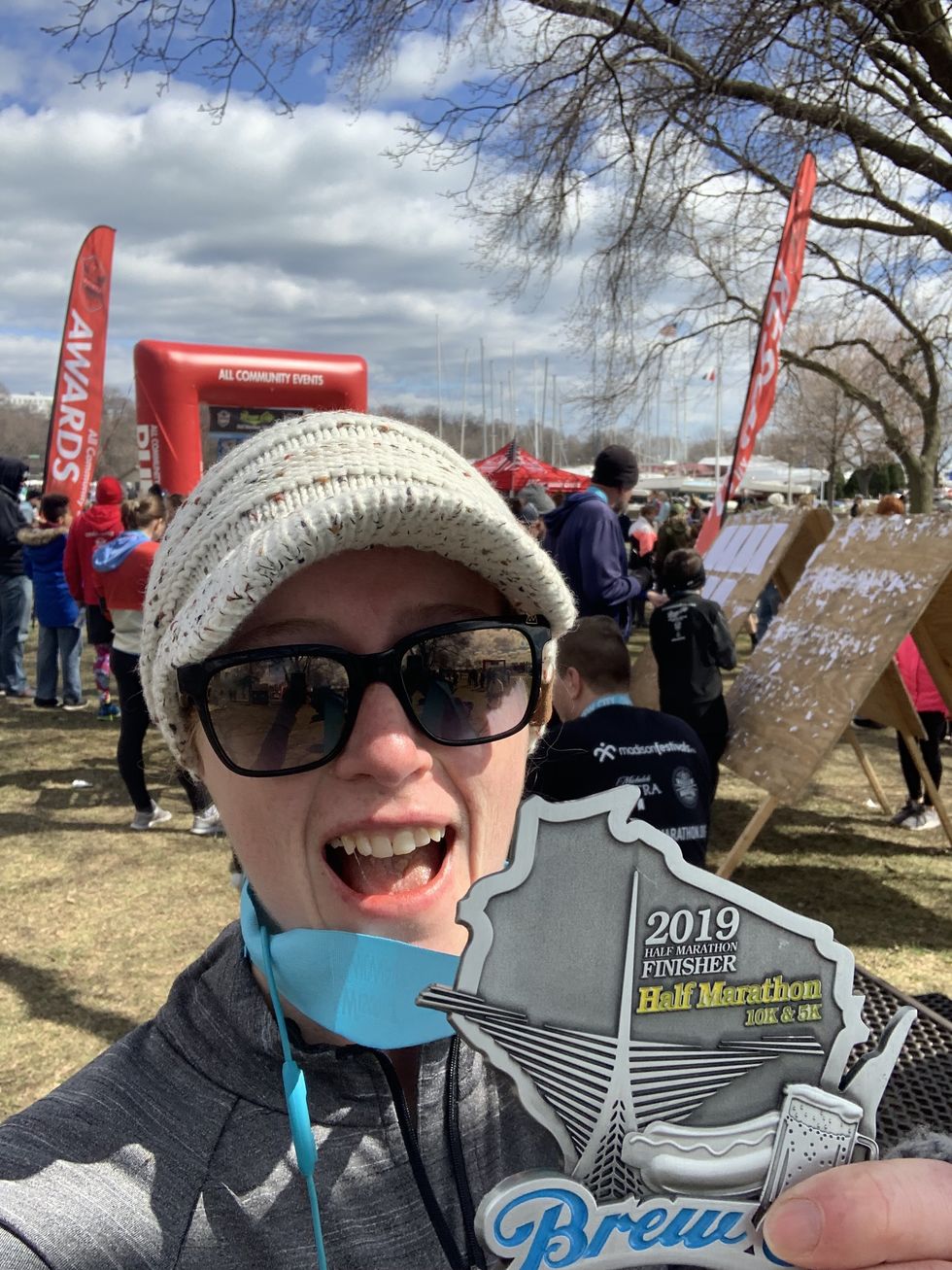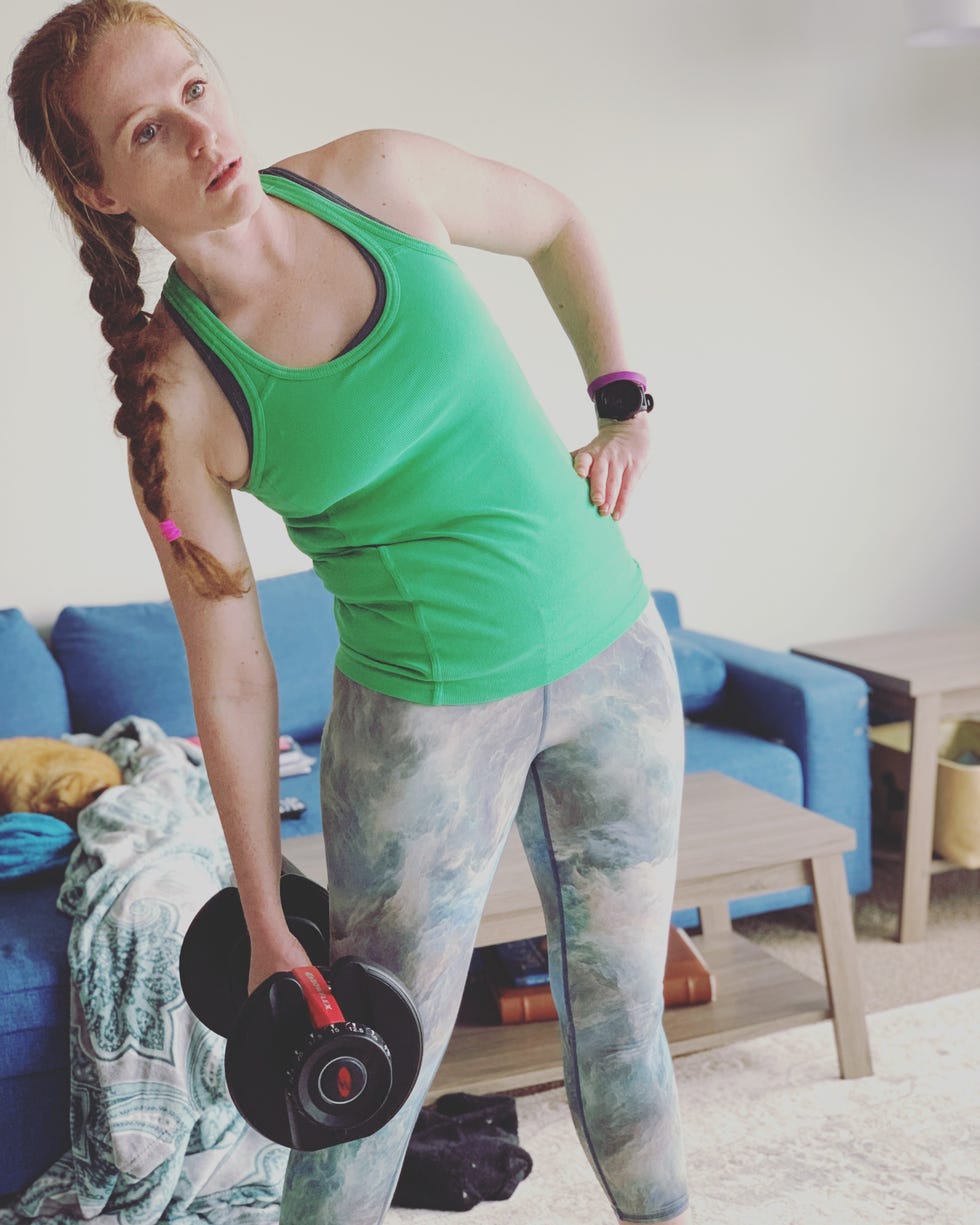When Stacey Halse, 31, of Milwaukee, Wisconsin, moved from Florida to Boston in 2009 for veterinary school, the rich running history of her new city sucked her in. Before, she had been a swimmer, but pools that were convenient—and affordable—were harder to find up north, so the roads began to beckon to her.
“I found the cheaper sport to do was running,” she tells Runner’s World. “I fell in love with running and racing in Boston, finding distance medley races through the Boston Athletic Association. I wasn’t fast at all, but running went from being purely for exercise to pure enjoyment.”
[Want to start running? The Big Book of Running for Beginners will take you through everything you need to know to get started, step by step]
Running gave her happiness, but it also helped her strive toward health: Four years before her move to Boston—just after she graduated high school—Halse was diagnosed with lupus, an autoimmune disease that causes the immune system to attack healthy tissues and organs.
“I was losing a lot of hair and was having trouble breathing,” she says. “I also started having arthritis symptoms—it was so bad I couldn’t even tie my shoes.”
Her doctors ordered tests, and found she had inflammation in her lungs. Her blood tests showed low platelet levels.
Once they determined it was lupus, doctors put her on medication and steroids to help manage her symptoms.
“I didn’t know what to feel—I had never dealt with anything like this. I went straight into college in 2005, and got steroid face,” Halse says. “I became really self-conscious and depressed from my diagnosis. The first six months were really hard for me. But I eventually found friends who had lupus that were my age that I could talk to about it and help me with what my life was like now with lupus.”
Running Through Symptoms—and Knowing When to Slow Down
Halse graduated and continued pursuing her veterinary medicine education, with hopes of becoming a veterinary ophthalmologist. It was there during vet school in Boston where she swapped swimming for running.
During that time, though, Halse’s lupus started causing issues breathing due to inflammation in her lungs.
“My symptoms had been relatively controlled since 2005, but my breathing problems became more significant during vet school,” she says. “I would breathe deeply, it would hurt really badly. The first five minutes of my runs were the most painful, but as my lungs expanded more, it would become less and less painful. I usually have to run really slowly and force myself to take deep breaths to make runs easier.”
Besides her breathing problems, her lupus remained mainly dormant. She didn’t have another flare until 2013, when she was living in New Jersey for her first internship after vet school.
This time, her kidneys were affected.
Her ankles began to swell, and she started to feel tired all the time. At first, she thought it was just fatigue linked to starting her difficult internship. But they were actually signs of kidney failure—which blood work confirmed.
One of Halse’s most difficult days was on April 24, 2014, when her doctors told her she would need to leave her internship.
“My immune system was attacking my kidneys, so they were not able to function appropriately, and I became nephrotic, meaning I was passing too much protein in my urine,” she says. “I had to back down from my internship, from exercise. I just had to do a lot of sitting around.”
Her doctors put her on high-dose steroids and the same kind of immunosuppressants that organ transplant patients are on.
“I had to isolate myself because I basically had no immune system,” Halse says.
It was a tough recovery, but by late 2015, she had moved back to Boston for her veterinary residency, and her kidneys were “clear” and functioning properly again. She started to feel better and was able to stop heavy medication. Biopsies revealed no long-term damage, though docs still closely monitor her kidneys.
Beat a Flare, Set a Major Running Goal
Once she was cleared by her doctors, she was back to running—and decided to do it big: She had her sights set on trying her first half marathon.
But Halse’s doctors were not as pumped as she was.
“My doctors initially didn’t want me to do it because I had been in kidney failure and didn’t want me to put additional stress on my kidneys,” she says. “Muscle breakdown happens when doing longer runs, and the product of muscle breakdown can damage your kidneys. I just had to make sure I wasn’t doing anything in excess because my kidneys were more sensitive.”
So in order to clear the half-marathon goal, her doctors prescribed blood work every two weeks to make sure her kidneys were handling the extra work. All of her tests came back fine during her training, and she was able to run her first half marathon: the Distance Medley in Boston in October of 2017.
Since then, Halse has done a plethora a halfs, 10Ks and 5Ks, but always must remain vigilant about her lupus and flare-ups.
“With lupus, you can get a lot of fatigue. You never know when it’s going to come. It just kind of surprises you,’ she says. “Some mornings I feel so fatigued it’s hard for me to get out of bed. I’ve just learned to listen to my body. Some days I might have to skip runs, shorten runs, or do a run later in the day than I had intended.”
Halse also makes sure to eat a healthy diet to help her body function as efficiently as possible. That’s evident on her Instagram page @staceyruns2eat, which is full of power bowls and bright veggie salads. Her diet emphasizes produce like fruits and vegetables to help ward off inflammation—though she does allow herself a good beer every now and then—and she adjusts her diet to remove foods that may make her feel more fatigued the next day.
Right now, her lupus has now stable, but she still experiences arthritis and pain in her lungs from time to time. When she does, she checks in with her doctors to make sure nothing else is going on.
This past year, she participated in the Lupus Foundation of America Walk to End Lupus Now, a nation-wide walk held in cities across the U.S. Her goal for 2019 is to do 19 races.
To get there, she trains three to four times a week, logging between 15 to 30 miles total. Her doctors have recently encouraged her to add in strength training to help her joints, so she enjoys lifting weights and doing strength workouts at home between running days.
“I want encourage those runners that do have lupus or any other chronic disease that running can still be done—don’t be scared of it,” she says. “I limited myself so much when I was first diagnosed. I was afraid it might cause my lupus to get worse. But you just have to be brave, and always talk to your doctors about your goals.”
Emily Shiffer has worked as a writer for over 10 years, covering everything from health and wellness to entertainment and celebrities. She previously was on staff at SUCCESS, Men's Health, and Prevention magazines. Her freelance writing has been featured in Women's Health, Runner's World, PEOPLE, and more. Emily is a graduate of Northwestern University, where she majored in magazine journalism at the Medill School of Journalism and minored in musicology. Currently residing in Charleston, South Carolina, Emily enjoys instructing barre, surfing, and long walks on the beach with her miniature Dachshund, Gertrude.















